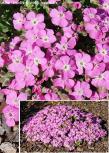Daphne cneorum

Daphne cneorum
garland flower
garland flower
| SIZE/TYPE | low or groundcovering |
|---|---|
| small shrub | |
| USUAL HEIGHT | 0.2-0.3m |
| USUAL WIDTH | 0.3-0.8m |
| LEAVES | evergreen broadleaf |
| COLOUR OF LEAVES |
 green green |
| FLOWERS | showy |
| COLOUR OF FLOWERS |
 pink pink
|
| BLOOMING TIME | May - June |
| LOCATION | full sun |
| SOIL TYPE | any (acidic to alkaline) |
| SOIL MOISTURE REQUIREMENTS | evenly moist (dislikes drought) |
| USDA zone (lowest) | 5b (down to -27°C) |
| WINTER PROTECTION | |
| FOR ZONE 5+6 |

|
| FOR ZONE 7 |

|
| BELONGS TO CATEGORIES |
Evergreen broadleaf Rarities |
Daphne is a large genus of about 50 species. They are deciduous or evergreen, and commonly renowned for their very fragrant flowers. Garland flower is a European species, our native which can be found at the border of pine and oak woods and creeping over rocky embankments. Unfortunately, in Czech landscape it has become endangered and you can see less and less of it growing in the wild.
Garland flower is best cultivated as a rocky plant in the garden. It forms neat, low cushions with densely leaved, erect branches if grown in full sun. At their tips appear clusters of immensely fragrant flowers in late spring. Small leaves are evergreen, lance-shaped to narrowly obovate, dark green, and partly glossy.
It naturally grows in sharply drained soil which is rather dry yet not as dry as a xeriscape. In woodland conditions with filtered sunlight it loses its compact habit and makes longer, sun seeking branches with leaves only at their tips. If the same happens to your plant, you can lightly trip it after flowering – it does not respond well to hard pruning.
Garland flower is a slow growing plant which is difficult to propagate and detests transplanting. Hence its higher price on garden centre shelves. Yet once established it makes a beautiful cushion you will admire for many years. Grow it in neutral to slightly acidic, well-drained soil, and keep it moist only for a few months after transplanting. Then do not water it ever again. It does not grow in pots. Do not fertilize but use soil fungi (mycorrhiza). Hardy to min. -27°C (USDA zone 5b), possibly a little lower.
Last update 01-03-2020
Garland flower is best cultivated as a rocky plant in the garden. It forms neat, low cushions with densely leaved, erect branches if grown in full sun. At their tips appear clusters of immensely fragrant flowers in late spring. Small leaves are evergreen, lance-shaped to narrowly obovate, dark green, and partly glossy.
It naturally grows in sharply drained soil which is rather dry yet not as dry as a xeriscape. In woodland conditions with filtered sunlight it loses its compact habit and makes longer, sun seeking branches with leaves only at their tips. If the same happens to your plant, you can lightly trip it after flowering – it does not respond well to hard pruning.
Garland flower is a slow growing plant which is difficult to propagate and detests transplanting. Hence its higher price on garden centre shelves. Yet once established it makes a beautiful cushion you will admire for many years. Grow it in neutral to slightly acidic, well-drained soil, and keep it moist only for a few months after transplanting. Then do not water it ever again. It does not grow in pots. Do not fertilize but use soil fungi (mycorrhiza). Hardy to min. -27°C (USDA zone 5b), possibly a little lower.
Last update 01-03-2020
SIZES and PRICES
CURRENTLY SOLD OUT
GLOSSARY
|












